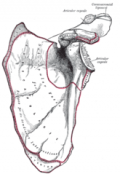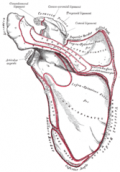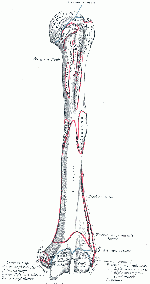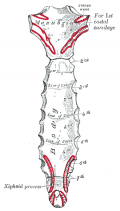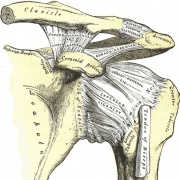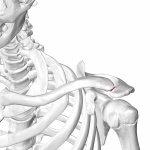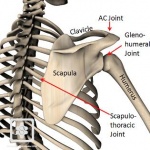Introduction
The shoulder complex, composed of the clavicle, scapula, and humerus, is an intricately designed combination of three joints, the Glenohumeral Joint, the Acromioclavicular Joint and the Sternoclavicular Joint, that links the upper extremity to the axial skeleton at the thorax and work collectively with the Scapulothoracic Joint to achieve normal shoulder girdle movements. [1] Movements of the shoulder complex represent a complex dynamic relationship between muscles forces, ligament constraints and bony articulations. The articular structures of the shoulder complex, in particular the Glenohumeral Joint, are designed primarily for mobility, allowing us to move and position the hand through a wide range of space, allowing the greatest range of motion of any joint in the body.[1][2]
The freedom of movement has been developed at the expense of stability, and it is these competing mobility and stability demands combined with an intricate structural and functional design which make the shoulder complex highly susceptible to dysfunction and instability. The shoulder demonstrates a unique functional balance between mobility and stability through active forces, known as Dynamic stabilisation, which is the reliance on active forces or dynamic muscular control rather than passive stabilisation through passive forces such as articular surface configuration, capsule, or ligaments. Thus in the shoulder, it is muscle forces which serve as the primary mechanism for securing the shoulder girdle to the thorax and providing a stable base of support for upper extremity movements, [1][2]
Osteology
The osseous segments of the shoulder complex comprise of the clavicle, scapula, humerus and sternum
Clavicle
The Clavicle is located between the Sternum and the Scapula, and it connects to the body through the Humerus.[3] The clavicle is the first bone in the human body to begin intramembranous ossification directly from mesenchyme during the fifth week of fetal life. Similar to all long bones, the clavicle has both a medial and lateral epiphysis. The growth plates of the medial and lateral clavicular epiphyses do not fuse until the age of 25 years. Peculiar among long bones is the clavicle’s S-shaped double curve, which is convex medially and concave laterally. This contouring allows the clavicle to serve as a strut for the upper extremity, while also protecting and allowing the passage of the Axillary Vessels and Brachial Plexus medially.[1][4]
Scapula
The Scapula, commonly referred to as the Shoulder Blade, is a highly mobile, thin, flat triangular-shaped bone placed on the postero-lateral aspect of thoracic cage . It has two surfaces, three borders, three angles and three processes.[1][6]
- The slightly concave anterior aspect of the bone is called the subscapular fossa, which allows the scapula to glide smoothly along the convex posterior rib cage.
- The glenoid fossa is the slightly concave, oval-shaped surface that accepts the head of the humerus, composing the glenohumeral joint.
- The superior and inferior glenoid tubercles border the superior and inferior aspects of the glenoid fossa and serve as proximal attachments for the long head of the biceps and the long head of the triceps, respectively.
-
The scapular spine divides the posterior aspect of the scapula into the supraspinatous fossa (above) and the infraspinatous fossa (below).
- The acromion process is a wide, flattened projection of bone from the most superior-lateral aspect of the scapula. The acromion forms a functional “roof” over the humeral head to help protect the delicate structures within that area.
- The coracoid process is the finger-like projection of bone from the anterior surface of the scapula, palpable about 1 inch below the most concave portion of the distal clavicle. The coracoid process is the site of attachment for several muscles and ligaments of the shoulder complex.
- The medial and lateral borders of the scapula meet at the inferior angle, or tip, of the scapula. Clinically, the inferior angle is important in helping track scapular motion. Read more…
Humerus
The humerus is the both the largest bone in the arm and the only bone in the upper arm. It is located between the shoulder and the elbow joint . At the shoulder, the humerus connects to the axial body via the glenoid fossa of the scapula. At the elbow, it connects primarily to the ulna, as the forearm’s radial bone connects to the wrist. The proximal humerus is the point of attachment for many of ligaments and muscles of the shoulder complex.
- The Humeral Head is nearly one half of a full sphere that articulates with the glenoid fossa forming the Glenohumeral Joint.
- The Lesser Tubercle is a sharp, anterior projection of bone just below the humeral head.
- The Greater Tubercle, forms a more rounded lateral projection of bone.
- The Intertubercular Groove, often referred to as the Bicipital Groove because it houses the tendon of the long head of the biceps, divides the greater and lesser tubercles.
- The Deltoid Tuberosity, which is the distal insertion for all three heads of the deltoid muscle, lies more distally, on the lateral aspect of the upper one third of shaft of humerus.
- The Radial or Spiral Groove, which helps define the distal attachment for the lateral and medial heads of the triceps, runs obliquely across the posterior surface of the humerus. The radial nerve follows this groove. Read more…
Sternum
The sternum is a flat bone, located at the midpoint of the anterior thorax, is composed of the manubrium, the body, and xiphoid process.
- The manubrium is the most superior portion of the sternum which articulates with the first rib of both sides, the upper part of the second costal cartilage and clavicle forming the Sternoclavicular Joint. The manubrium is quadrangular and lies at the level of the 3rd and 4th thoracic vertebrae. The jugular notch is the thickest part of the bone and is convex along anterior and concave along the posterior side.[1][6]
- The body of the sternum is longer and thinner. It has margins that articulates with the first cartilages of Ribs 2 through 7. [1][6]
- The xiphoid process, meaning “Sword Shaped”, is the inferior tip of the sternum and also the smallest part. It doesn’t articulate with the ribs. The xiphoid process anchors several important muscles like the rectus abdominus muscle and the transversus thoracis muscle, including the abdominal diaphragm, a muscle that is necessary for normal breathing.[1][6]
Joints
In all there are four major articulations associated with the Shoulder Complex involving the sternum, clavicle, ribs, scapula, and humerus, which work together to provide large ranges of motion to the upper extremity in all three plane of motion. Movement at the Shoulder Complex occurs as a result of movement at each of these four joints. The interplay of 4 articulations (Glenohumeral Joint, Acromioclavicular Joint, Sternoclavicular Joint and Scapulothoracic Joint) of the shoulder complex, results in a coordinated movement pattern of the arm elevation. The involved movements at each joint are continuous, although occurring at various rates and at different phases of arm elevation.
Glenohumeral Joint
The Glenohumeral Joint (GH Joint) is a true synovial ball-and-socket style diarthroidal joint that is responsible for connecting the upper extremity to the trunk. This joint is formed from the combination of the humeral head and the glenoid fossa of the scapula. Recall that the glenoid fossa is relatively flat, while the head of the humerus is a large, rounded hemisphere. This bony conformation, in conjunction with the highly mobile scapula, allows for abundant motion in all three planes but does not promote a high degree of stability. It is interesting to note that the ligaments and capsule of the GH Joint are relatively thin and provide only secondary stability to the joint, while the primary stabilizing force of this joint is gained from the surrounding musculature, in particular the rotator cuff muscles. This joint is considered to be the most mobile and least stable joint in the body, and is the most commonly dislocated diarthoidal joint. [1][11] The GH joint is a ball-and-socket joint that allows 3 degrees of freedom. The primary motions of this joint are abduction and adduction, flexion and extension, and internal and external rotation but also allow horizontal abduction and horizontal adduction. Read more…
Acromioclavicular Joint
The Acromioclavicular Joint (AC Joint) is a gliding, or plane style synovial joint that is formed by the junction of the lateral clavicle and the acromion process of the scapula. It attaches the scapula to the clavicle and serves as the main articulation that suspends the upper extremity from the trunk.[1] In essence, this joint links the motion of the scapula (and attached humerus) to the lateral end of the clavicle. Because strong forces are frequently transferred across the AC joint, several important stabilizing structures are required to maintain its structural integrity. The AC joint allows motion in all three planes: Upward and downward rotation, rotation in the horizontal plane (internal and external rotation), and rotation in the sagittal plane (anterior and posterior tilting). These relatively slight but important adjustment motions help to fine-tune the movements between the scapula and the humerus. Equally important, these motions allow the scapula to maintain firm contact with the posterior thorax. Read more…
Sternoclavicular Joint
The Sternoclavicular Joint (SC Joint) is formed from the articulation of the medial aspect of the Clavicle and the Manubrium of the Sternum. This joint provides the only direct bony attachment of the upper extremity to the axial skeleton, accordingly, the joint needs to be both stable while also allowing extensive mobility. It has a fibrocartilage articular disk with a network of strong, thick ligamentous reinforcements, often resulting in fracture of the clavicle before a dislocation of the SC Joint occurs.[1] The SC Joint structure is a saddle joint with concave and convex surfaces on each of the joint’s articular surfaces. This conformation allows the clavicle to move in all three planes. Motions include elevation and depression, protraction and retraction, and axial rotation. Read more…
Scapulothoracic Joint
Although referred to as the Scapulothoracic Joint, the articulation between the scapula and the thorax is not a “true” joint as it does not have the characteristics of a fibrous, cartilaginous, or synovial joint. It is an articulation of the anterior aspect of the scapula on the posterior thorax. It typically refers to the motion of the scapula relative to the posterior rib cage. The SC Joint and AC Joint are interdependent with the Scapulothoracic Joint as the scapula is attached through the acromion process to the lateral end of the clavicle and through the AC Joint; the clavicle, in turn, is attached to the axial skeleton at the manubrium of the sternum through the SC Joint. Any movement of the scapula on the thorax thus result in movement at either the AC Joint, the SC Joint, or both. Normal movement and posture of the Scapulothoracic Joint are essential to the normal function of the shoulder.[1] Motions at the scapulothoracic joint include elevation and depression, protraction and retraction, and upward and downward rotation. All motions are functionally linked to the motions that occur at the other three joints of the shoulder complex.
Bursae
A bursa is a synovial fluid filled sac, which acts as a cushion between tendons and other joint structures. In the shoulder region, we have 8 bursae, the most of any single joint in your body. The bursae have both a nerve supply and mechanoreceptors which aid propioceptive information of shoulder joint position. [14] This shows that bursae don’t strictly function as a lubricator between tissues. The upper limits of the bursae are the coraco-acromial ligament, acromion bone and the deltoid. The lower limits are the humeral head, the shoulder joint and the supraspinatus.[15]
- Subscapular Bursa or the Scapulothoracic Bursa: between the tendon of the subscapularis muscle and the shoulder joint capsule.
- Subdeltoid Bursa: between the deltoid muscle and the shoulder joint cavity.
- Subacromial Bursa: below the acromion process and above the greater tubercle of the humerus.
- Subcoracoid Bursa: between the coracoid process of the scapula and the shoulder joint capsule.
- Infraspinatus Bursa: between the infraspinatus tendon and the capsule of the joint.
- Subcutaneous Acromial Bursa: is located above the acromion just beneath the skin.
The Subacromial and the Subdeltoid Bursa are often taken as a single bursa, the Subacromial Deltoid Bursa. [16]
Soft Tissue
Movement at the Shoulder Complex occurs as a result of movement at each of the four joints, and it is the interaction of the four joints which allow normal movement of the shoulder to occur.The interplay of 4 articulations (Glenohumeral Joint, Acromioclavicular Joint, Sternoclavicular Joint and Scapulothoracic Joint) of the shoulder complex, results in an coordinated movement pattern of the arm elevation. The involved movements at each joint are continuous, although occurring at various rates and at different phases of arm elevation.Shoulder stability is achieved through the interplay of both static and dynamic stabilisers, which work in synchrony to maintain shoulder stability during movements of the shoulder. Understanding the complex interplay between these static and dynamic components are key for effective assessment and management of shoulder conditions. The biomechanics of the glenohumeral joint depend on the interaction of both static and dynamic-stabilizing structures.
Static Stabilisers
Static stabilizers are the non-contractile tissue of the glenohumeral joint and play a key role in maintinaing shoulder stability at end-range and/or when there is a dysfunction of the dynamic stabilizers. These static stabilizers set the base of support for the shoulder joint
Articular Surfaces and Bony Geometry
The bony geometry of the gleno- humeral joint is conducive to excessive joint mobility but sacrifices osseous stability. It is thicker at the periphery, and provides the foundation for concativy-compression effect of Rotator Cuff Muscles.
Glenoid Labrum
The Glenoid labrum is a fibrocartilaginous, ridge like connective tissue which increases articular surface area for the humeral head by deepening the glenoid fossa. It provides the primary attachment for the glenohumeral ligaments, and gives rise to long head biceps tendon, capsule, and scapular neck. It conforms to the curvature of the humeral head and as such contributes to approximately 50% of depth of shoulder joint. Stretches out anteriorly with external rotation, stretches out posteriorly with internal rotation. A loss of labrum integrity has been shown to decrease the resistance to translation by 20%.
Joint Capsule
The joint capsule that surrounds the glenohumeral joint is also an important passive stabilizer of the shoulder joint. The glenohumeral joint capsule is thickened at the front of the capsule and is twice the size of the humeral head. Ir provides most of its extensibility anteriorly and inferiorly and it “Winds up” during abduction and external rotation. The joint capsule and glenohumeral ligaments are intimately adherent anatomically and mainly function as stabilizers at the extremes of motion. This static end-range stabilization is very important when all other stabilizing mechanisms are overwhelmed. The joint capsule has an inherit negative intra-articular pressure that holds the joint together.
Ligaments
Glenohumeral Ligaments
There are 3 main ligaments in the glenohumeral joint:
- Superior Ligament limits ER and inferior translation of the humeral head and parallels the course of the coracohumeral ligament.
- Middle Ligament limits ER and Anterior Translation at 45° of Abduction.
- Inferior Ligament is the thickest of the ligaments and consists of 3 different portions: anterior band, posterior band, and the axillary pouch.
Coracohumeral Ligament
Covers the superior glenohumeral joint anteriorly-superiorly, and fills the space between the tendons of the Supraspinatus and Subscapuaris Muscles, uniting these tendons. Limits anterior and inferior translation at lower levels of elevation, extension, and extension with adduction (Izumi et al 2011).
Coracromial Ligament
Consists of a strong triangular band, extending between the coracoid process and the acromion, that together with these structures, forms a vault for the protection of the head of the humerus.
Dynamic Stabilisers
The dynamic stabilisers of the shoulder complex include include the active, contractile tissues including the rotator cuff muscles, the deltoid muscles, the scapular muscles that control scapulohumeral rhythm and the associated sensorimotor system involved with proprioception, kinesesia, and the sensation of resistance. For optimal shoulder stabilization the dynamic stabilizers must be working in an efficient synergistic fashion. These dynamic stabilisers assist with maintaining the position of the humeral head in the glenoid fossa during movement.[17] The deltoid muscle is a powerful abductor and elevator of the shoulder joint. However, it’s line of pull in isolation means it draws the head of the humerus superiorly upwards towards the coracoacromial arch. It is essential that the rotator cuff muscles (infraspinatus, teres minor, supraspinatus and subscapularis) activate in synergy with the deltoid during overhead activities to pull the humeral head inferiorly or downwards and upward drift of the humerus. Dynamic stabilization results in a wide range of mobility for the shoulder complex and provides adequate stability when the complex is functioning normally. Dynamic stability occurs as a result of three key factors. dynamic stability. [18]
- Resistance to translation from opposite side pull of muscles
- Support of same side structures through muscle stiffness/capsular tensioning
- Synergistic force coupling for efficient controlled axis of rotation/motion
Primary Dynamic Stabilisers
- Rotator Cuff Muscles (Supraspinatis, Infraspinatis, Teres Minor, Subscapularis). While these muscles have quite a small cross-sectional area and size, are closer to center of rotation on which they act, with a short lever arm, and generate small forces, they play a major role in the dynamic stabilisation of the shoulder. They also blend with the joint capsule which also assists to reinforce the joint capsule.
- Long Head of Biceps
- Deltoid function includes prevention of subluxation or dislocation of the head of the humerus particularly when carrying a load and is the prime mover in shoulder abduction.
Secondary Dynamic Stabilisers
- Teres Major is a small muscle that runs along the lateral border of the scapula. It forms the inferior border of both the triangular space and quadrangular space.It’s sometimes called “lat’s little helper” because of its synergistic action with the latissimus dorsi.[19]
- Latissimus Dorsi whose name means “broadest muscle of the back,” is one of the widest muscles in the human body. Also known as the “lat,” it is a very thin triangular muscle that is not used strenuously in common daily activities but is an important muscle in many exercises such as pull-ups, chin-ups, lat pulldowns, and swimming.[20]
- Pectoralis Major is a thick, fan-shaped muscle, situated at the chest which makes up the bulk of the chest muscles and lies under the breast.
Scapulohumeral Rhythm
The actions of the shoulder are paired with actions of the scapula. This serves to both increase the available range of motion of the upper extremity, and allows the glenoid fossa to be positioned in a more stable position in relation to the humeral head. Scapulohumeral rhythm is the kinematic interaction between the scapula and the humerus, first published by Codman in the 1930s. [21] This interaction is important for the optimal function of the shoulder. [22] Scapulohumeral rhythm or ratio is significantly greater (less scapular motion and more humeral motion) in the sagittal plane than other planes. Consistent with the findings, the dominant side demonstrates significantly higher values for SH rhythm than the non-dominant side but only in the coronal and scapular planes. [23]
The scapulohumeral rhythm is therefore defined as the ratio of the glenohumeral movement to the scapulothoracic movement during arm elevation. This is most often calculated by dividing the total amount of shoulder elevation (humerothoracic) by the scapular upward rotation (scapulothoracic). [24] In the literature Scapulohumeral rhythm is descibed as a ratio of humeral elevation:scapulothoracal rotation. The overall ratio of 2:1 during arm elevation is commonly used. According to the 2-to-1 ratio frame-work, flexion or abduction of 90° in relation to the thorax would be accomplished through approximately 60° of GH and 30° of ST motion. [25]
Scapulohumeral rhythm is a common metric for assessing muscle function and shoulder joint motion.[26] There is a three-dimensional scapular kinematic pattern during normal arm elevation that include upward rotation, posterior tilting and varying internal/external rotation dependent on the plane and angle of elevation. [21] [22] When there is a changement of the normal position of the scapula related to the humerus, this can cause dysfunction of the scapulohumeral rhythm, often referred to as scapular dyskinesia.
Resources
References
- ↑ 1.001.011.021.031.041.051.061.071.081.091.101.11 Levangie PK, Norkin CC. Joint Structure and Function: A Comprehensive Analysis. FA Davis; 2011 Mar 9.
- ↑ 2.02.1 Veeger HE, Van Der Helm FC. Shoulder Function: The Perfect Compromise between Mobility and Stability. Journal of Biomechanics. 2007 Dec 31;40(10):2119-29.
- ↑ American Academy of Orthopaedic Surgeons. Clavicle Fracture (Broken Collarbone). www.orthoinfo.aaos.org/topic.cfm?topic=a00072
- ↑ Paladini P, Pellegrini A, Merolla G, Campi F, Porcellini G. Treatment of Clavicle Fractures. Translational [email protected] UniSa. 2012 Jan;2:47.
- ↑ By Henry Vandyke Carter – Henry Gray (1918) Anatomy of the Human Body. Bartleby.com: Gray’s Anatomy, Plate 202, Public Domain, ↑ 6.06.16.26.3 Standring S, editor. Gray’s Anatomy E-Book: The Anatomical Basis of Clinical Practice. Elsevier Health Sciences; 2015 Aug 7. Level of Evidence: 5
- ↑ By Henry Vandyke Carter – Henry Gray (1918) Anatomy of the Human Body. Bartleby.com: Gray’s Anatomy, Plate 203, Public Domain, ↑ By Henry Vandyke Carter – Henry Gray (1918) Anatomy of the Human Body. Bartleby.com: Gray’s Anatomy, Plate 207, Public Domain, https://commons.wikimedia.org/wiki/File:Gray207.png
- ↑ By Henry Vandyke Carter – Henry Gray (1918) Anatomy of the Human Body. Bartleby.com: Gray’s Anatomy, Plate 116, Public Domain, https://commons.wikimedia.org/w/index.php?curid=792133
- ↑ By Henry Vandyke Carter – Henry Gray (1918) Anatomy of the Human Body. Bartleby.com: Gray’s Anatomy, Plate 202, Public Domain, ↑ Dodson, C.C. and Cordasco, F.A. (2008). Anterior Glenohumeral Joint Dislocations. Orhtopedic Clinics of North America, 39(4), 507-518.
- ↑ By BodyParts3D is made by DBCLS. – Polygon data is from BodyParts3D, CC BY-SA 2.1 jp, ↑ By Dr. Johannes Sobotta [Public domain], via Wikimedia Commons. Dr. Johannes Sobotta – Sobotta’s Atlas and Text-book of Human Anatomy 1909. https://commons.wikimedia.org/wiki/Category:Sternoclavicular_joint#/media/File:Sobo_1909_192.png
- ↑ Hsieh LF, Hsu WC, Lin YJ, Wu SH, Chang KC, Chang HL. Is Ultrasound-guided Injection more Effective in Chronic Subacromial Bursitis?. Medicine and Science in Sports and Exercise. 2013 Dec;45(12):2205-13. Level of Evidence: 1B
- ↑ Conduah, Augustine H., and Champ L. Baker. “Clinical Management of Scapulothoracic Bursitis and the Snapping Scapula.” Sports Health: A Multidisciplinary Approach 2.2 (2010): 147-155. Level of Evidence: 3A
- ↑ Hitzrot, James Morley. Surgical Diseases of the Shoulder Bursae. Annals of Surgery 98.2 (1933): 273. Level of Evidence: 4
- ↑ Guerrero P, Busconi B, Deangelis N, Powers G. Congenital Instability of the Shoulder Joint: Assessment and Treatment Options. JOSPT. 2009;39(2):124-134.
- ↑ Wilk KE, Arrigo CA, Andrews JR. Current concepts: the stabilizing structures of the glenohumeral joint. Journal of Orthopaedic & Sports Physical Therapy. 1997 Jun;25(6):364-79.
- ↑ Biel A (2005). Trail Guide to the Body (2nd ed). Boulder, CO: Books of Discovery.
- ↑ Ahlke Heydemann, Severe Murine Limb-girdle Muscular Dystrophy Type 2C Pathology is Diminished by FTY720 Treatment, Muscle & Nerve, 3, 56, , 2007 486-494
- ↑ 21.021.1 Codman EA: The Shoulder,Boston: G.Miller & Company,1934
- ↑ 22.022.1 Kibler WB. The role of the scapula in athletic shoulder function. Am J Sports Med 1998;26:325-337 Level of Evidence: 3B
- ↑ Barnes CJ, Van Steyn SJ, Fischer RA: The effects of age, sex, and shoulder dominance on range of motion of the shoulder. J Shoulder Elbow Surg 2001; 10:242– 246. Level of Evidence:4.
- ↑ Struyf, F., Scapular Positioning and Movement in Unimpaired Shoulders, Shoulder Impingement Syndrome, and Glenohumeral Instability, Scandinavian Journal of Medicine and Science in Sports, jrg20, nr3, 2011, p352. Level of Evidence: 4.
- ↑ Inman B, Saunders J, Abbott L: Observations of function of the shoulder joint. J Bone Joint Surg Br 2004; 26:1. Level of Evidence: 4.
- ↑ McQuade K, Smidt G: Dynamic Scapulohumeral Rhythm: The Effects of External Resistance during Elevation of the Arm in the Scapular Plane. J Orthop Sports Phys Ther 1998; 27:125–133.
- ↑ Jason Mensinger. Shoulder Complex Biomechanics. Available from: ↑ Jason Mensinger. Shoulder Complex Biomechanics 2. Available from: ↑ Jason Mensinger. Shoulder Complex Biomechanics 3. Available from: function gtElInit() { var lib = new google.translate.TranslateService(); lib.setCheckVisibility(false); lib.translatePage('en', 'pt', function (progress, done, error) { if (progress == 100 || done || error) { document.getElementById("gt-dt-spinner").style.display = "none"; } }); }

